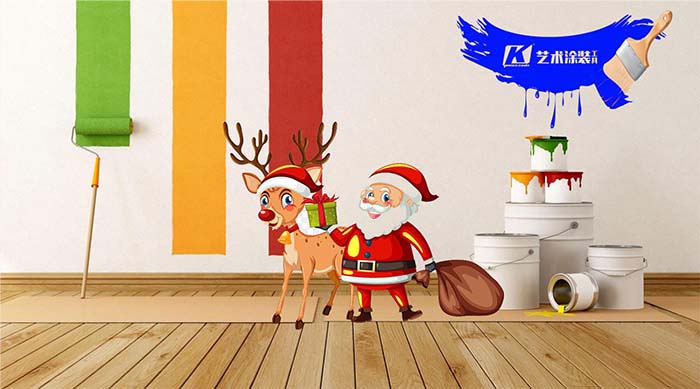
There are several colors which are traditionally associated with Christmas. This site uses Red, Green and Gold. But why do we have them and what do the colors represent? Most the colors and their meanings come from the western/northern European traditions and customs, when Christmas is in the middle of winter and it's dark and cold.
Green - Christmas Holly: Evergreen plants, like Holly, Ivy and Mistletoe have been used for thousands of years to decorate and brighten up buildings during the long dark winter. They also reminded people that spring would come and that winter wouldn't last forever! The Romans would exchange evergreen branches during January as a sign of good luck. The ancient Egyptians used to bring palm branches into their houses during the mid-winter festivals.
In many parts of Europe during the middle-ages, Paradise plays were performed, often on Christmas Eve. They told Bible stories to people who couldn't read. The 'Paradise Tree' in the garden of Eden in the play was normally a pine tree with red apples tied to it. Now the most common use of green at Christmas is Christmas Trees.
Red - Cartoon drawing of Santa Claus: As mentioned above, an early use of red at Christmas were the apples on the paradise tree. They represented the fall of Adam in the plays. Red is also the color of Holly berries, which is said to represent the blood of Jesus when he died on the cross. Red is also the color of Bishops robes. These would have been worn by St. Nicholas and then also became Santa's uniform!
Gold - A gold five-pointed star: Gold is the color of the Sun and light - both very important in the dark winter. And both red and gold are the colors of fire that you need to keep you warm. Gold was also one of the presents brought to the baby Jesus by one of the wise men and traditionally it's the color used to show the star that the wise men followed. Silver is sometimes used instead of (or with) gold. But gold is a 'warmer' color.
White - A Snowflake: White is often associated with purity and peace in western cultures. The snow of winter is also very white! White paper wafers were also sometimes used to decorate paradise trees. The wafers represented the bread eaten during Christian Communion or Mass, when Christians remember that Jesus died for them. White is used by most churches as the color of Christmas, when the altar is covered with a white cloth (in the Russian Orthodox Church Gold is used for Christmas).
Blue - Mary being visited by the Angel: The color blue is often associated with Mary, the mother of Jesus. In medieval times blue dye and paint was more expensive than gold! So that, it would only be worn by Royal families and very rich people. Mary was often painted wearing blue to show she was very important. Blue can also represent the color of the sky and heaven.
Purple - During Advent, purple and sometimes blue is used in most churches for the color of the altar cloth (in the Russian Orthodox Church red is used for advent).
When you are going to do anything to add a bit of joy to your abode, you are on the right track. We have some suggestions on how to use two color combination in order to create a trendy and unique room in Christmas 2021.
That is evident that color has the ultimate power to transform a room, whether it is vibrantly colored walls, a bold accent wall or an unexpected painted ceiling. However, it is tricky to find the right paint color and more importantly, the right color combination!
Deck the walls! Find inspiration from your home walls to create a beautifully decorated home for the holidays. As we head towards the end of the year, we can’t help being joyful about all the festivity and merriment around us, especially after the overwhelming and chaotic year that has been. While most of us will be spending Christmas from the safety of our homes, there is no reason why we can’t embrace the festive spirit and make every corner fun and festive.
When determining a color scheme for Christmas decorations, it is important to keep the focus on the overall colors you already have in your home. The walls make up the majority of any room and it is a good idea to complement your wall paint color with the right decor. We have gathered a few ideas for you to carry the color scheme inspired by your existing decor.
1:Blue Christmas
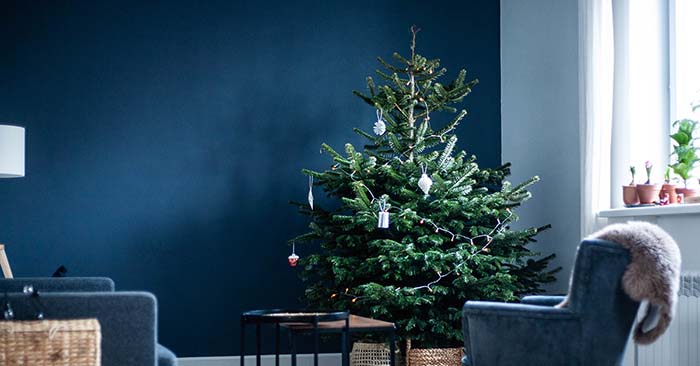
(Blue Christmas)
For a sophisticated color palette, incorporate hues of blue paired with green and silver and white accents. Paint your walls in deep rich blue color. From icy aquamarine to teal blue, this color is surprisingly festive when paired with traditional festive colors. Complement a deep blue wall with a green Christmas tree and glass ornaments in varying shades of blue.
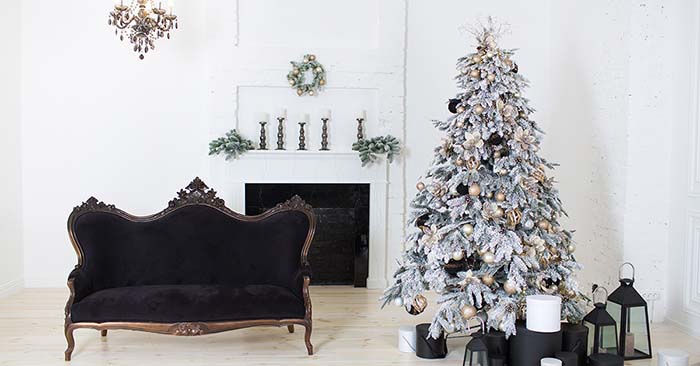
(monochrome mode)
Christmas has looked this classy! Black and white might not be a popular color scheme for this time of the year, but when styled well, it can be very warming and festive. Try adding twinkling fairy lights or a grand chandelier for some sparkle in a dark room. Go for a white, bushy tree to complement the white wall color.
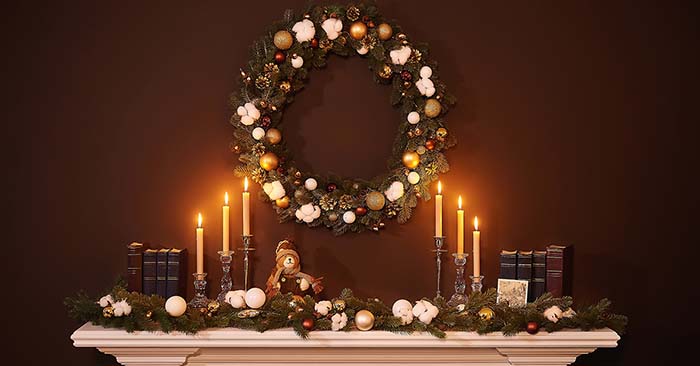
(Hot chocolate)
There is nothing quite like a delectable mug of hot chocolate on a cold, winter day. If this comforting drink took over your living room! Pick a deep chocolate colored wall paint for your space that is make sure to give it some warmth.
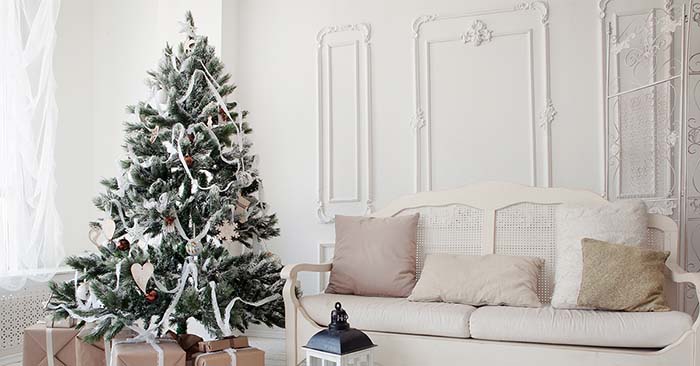
(White snow)
There is something mesmerizing about white snow during Christmas. However, dreaming of a white Christmas 2021 is almost impossible, unless you live in a cold area with white snow, where everything is snow-clad around this time of the year. The good news is that it is easy to mimic the snow with wintery white wall paint colors. Decorate the space with some twinkling white lights and charms to add in the festive feels.
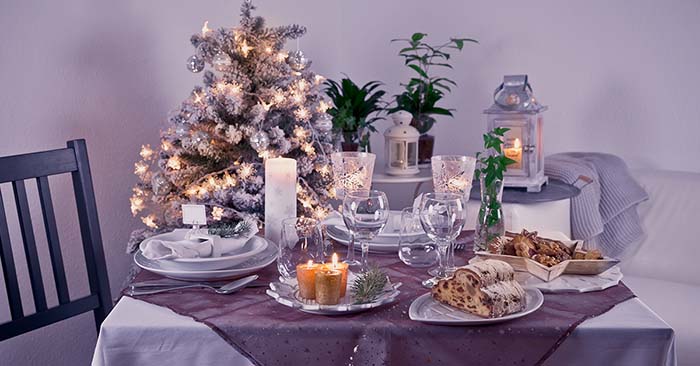
(Playful purple)
Traditionally associated with mystery and magic, hues of purple can add warm and glam to your holiday decor. Great alternative to traditional green and red color, purple is a great choice for a comfortability setting.
White walls are a blank canvas for festive decorations. Whether you choose to pick traditional red and green colors or wish to incorporate metallic accents with ornaments, white walls effortlessly complement both, over the top and simple, understated decorations. You could also choose to go all white to mirror that snowy and dreamy White Christmas look.
Soft, pastel tones will complement off-white or cream walls to bring out a sense of unity in your home decor. You can also opt for gold or brown color accents to help reflect the colors further and add warmth and sophistication to the space. When your wall color is a darker shade of grey, use white, gold and silver and for lighter shades, use dark grey and yellow for your decor. You could also complement a grey wall with yellow toned lights for a contrasting look that is sure to set your home decor apart.
If you have red walls, keep the decor muted and simple. Even a green wreath on the walls can add different textures and balance. Accents of golden yellow can work well when used in limited doses.
Dark green walls will highlight metallic hues in white and gold strikingly. Lighter green walls work best with minimalistic decor. Try using wooden decor that can be complement with dark green and metallic red.
For blue walls, green, white and silver can pair wonderfully. You can also add wooden and glass ornaments to your Christmas tree. Blue and green can be a great color combination, reminiscent of nature, it can give your home a calming, surreal vibe.
Traditional red and green color combinations might look out of place with pink walls. Instead, opt for silver and gold ornaments and soften up the ambience with yellow toned string lights.
For bright and warm colors like yellow and orange, using natural elements like branches, pine cones and foliage will add a unique look to your decor. For yellow walls, a combination of green and red can work or you can go metallic with silver toned accessories. For orange walls, add zest and spice with scarlet red and contrasting white.
There are two pretty overarching themes in terms of trends for this Christmas. The first is a movement towards being overtly and unapologetically festive. From layering luxe metallics to nostalgic color combinations and maximalist decorating - there’s clearly a yearning for all the festivities we may not have been able to have last year.
And for those who prefer things a little dialed back, nature prevails as a huge source of inspiration for festive styling. Earthy terracotta tones and sustainable materials are going to be high on people's wish lists this year, as we continually seek to bring our homes closer to nature.
The color theme for Christmas 2021 is all about joyful bright in both traditional colorways as well as contemporary alternatives such as magenta and blue are going to really bring the fun to your celebrations. On the other hand, muted colors are going to be a big trend. Tones of olive green, soft taupe, and caramel look effortlessly beautiful on a Christmas tree, and incredibly sophisticated.
Need to give your space a makeover and new personality without having to splurge on it? Paint is your best option hands down! For the longest time, while décor trends have swayed across different styles and periods, paint has continued to be the most durable, economic and simplest option that can change the entire look of a space in a matter of days. From protecting your surfaces to becoming a medium of self-expression, paint can anchor a surface effortlessly and create just the perfect mood you want to set in your space whether it’s the interiors or exteriors!
Interior paint finishes can literally make or break a space. The colors, textures and finishes can influence greatly the identity a space has. By using paints in a complementary or even a contrasting color scheme one can create a binding visual language.
Created originally using a mineral base, limewash paint has a lovely chalky & nuanced texture. The material dries to create a suave matte surface which gives any wall surface visual depth and a standout look. We used this in our most recent project in the modern colorful apartment and its one of our favorite looks with its cool concrete finish. This grey tone gives the space a super modern, clean & stark look that is oh so swoon-worthy.
Metallic finishes on walls are such a chic way to glam up your room’s vibe! Playing with metallic finishes can give the room an edgy & elegant look which is out of the box and unique. These walls can be created as accent walls in spaces so they have visual attention drawn up to them and can be the perfect backdrops for art / wall décor on the wall. Unleash your creativity and choose from a range of golden, champagne, silver or jewel tones to create that statement backdrop!
If you like to have fun with your walls and would like to take a little leap into a versatile palette of interior paint finishes, textured paint is just for you! With this type of paint finish, you can achieve unique patterns with absolute ease. Textured paint is perfect for a room facelift, is durable, versatile and can be customized to create the look you want.
Exterior paint finish is a functional and aesthetic layer that protects a building from all external factors from sun exposure to rainfall and any sort of wear and tear. Exterior finishes can set the tone of a built space literally at first sight! One must ensure that the finishes picked for the shell of the building matches the weather conditions of the site and the potential weather-related factors the building may need to endure. Properties like durability, water repellency and fungal prevention should be of prime focus while picking your finishes for exterior surfaces.
High on the style scale, the concrete exterior finish can give any-building a sharp stylish feel. You can channel some great Brutalist expression with exposed concrete facades and elevations to make your built space stand out and make its presence felt! There’s something so alluring about the rawness of this look and we feel it fits well with modern architecture and design especially with an industrial chic vibe.
Painted brick walls add an earthy look and feel that has an unconventional beauty of its own. The choice of colors can range from the classic earth tones to brick to bright hues! We are seeing a big trend towards dark exteriors and painting your brick exterior a sharp black or deep green or charcoal lends it a bold sharp look.
All in all, paint as a material is timeless. It’s the perfect medium for creative & visual expression that can be altered and customized to suit each homeowner’s personal style. So, the next time you are contemplating the perfect makeover for your spaces, whether at an interior or exterior level, be rest assured that paint and the plethora of finishes available in the market will breathe new life into your abode! That is all about finding the perfect shade, combination, texture and finish that will complement your style and give your space a whole new look.
It is very important to consider the current state of paint on your walls to gain clarity on the timelines of the painting project. If your house is new, chances are there are smooth surfaces on the walls, which will dramatically reduce the prep work. However, if this is about painting an old home with peeling walls, be prepared for longer hours of prep work. If you haven’t had your home painted in years, it may need special expertise, extra time and effort.
In project terms, scale means the overall extent of the project effort, usually accounting for cost, duration, complexity and resources. This enables projects to be characterised in comparative terms such as small, medium or large.
Having an idea of the cost of paint you need to purchase will help obtain quotes from a painting service. Figure how much paint is required to finish the project.
While there is no actual “painting season”, the time of year is key to get the best results, so be mindful of your local weather conditions. Schedule painting when the weather is moderate. Avoid extreme temperatures. Pick a dry time of year when there is less rain and low humidity. Paint needs time to dry and will not stick to surfaces if not dry. Nature can be quite unpredictable. Hence, reschedule if it has just rained or there is a possibility of rains.

Paint is one of the most creative ways to give your home an exciting new look. An accent wall can provide an instant ‘draw’ and be used in any room. It can break up a large room and highlight a particularly great architectural element, adding a sense of the extraordinary in an otherwise ordinary space. Read on for everything you need to know before you pick up a brush.
Consider the Décor You need to take into account your room’s architectural features, the amount of natural light, floor covering and furnishings before getting into home painting mode. If you have sleek furnishings, you can opt for an iridescent finish such as textured metallic for a sophisticated look. For décor that comprises rustic elements, you can choose a wall texture that exudes a raw appeal for an earthy look.
Measure the Chosen Wall - To find the area of a wall you wish to paint, multiply the wall height by wall width. If the wall happens to have a window or a door, simply subtract their square footage from that of the wall. We all know, you wouldn’t even dream of getting your favourite couch and other valuables damaged in the process, so keep them far from your project wall. Accept that paint will splatter; hence do not skip the drop cloth. Apply painters’ tape to shield outlets and switches from pesky paint drips.
Instructions to Paint - When applying paint with the roller on the wall, it is a good idea to use long strokes in a W pattern for ample coverage and to avoid those annoying roller marks! Once the wall is dry to the touch, you can go ahead with the second coat. If you also want to paint the trim, remove the painter’s tape and wait for the walls to dry, before applying tape to the walls.

(18 years experience in researching and developing different paint tools)
It is important to use good-quality paint to achieve professional results when it comes to wall painting for hall, kitchen, dining room, bedroom, balcony or any other corner of your home.
For walls of any type, it is a good idea to go for flat paints as they don’t reflect the light, which would otherwise show the imperfections of the wall. Flat paints tend to absorb light, masking the dings and dent.
Previous: How to Master cast iron?
Copyright:@2020-2021
Comments Please sign in or sign up to post.
0
0 of 500 characters used